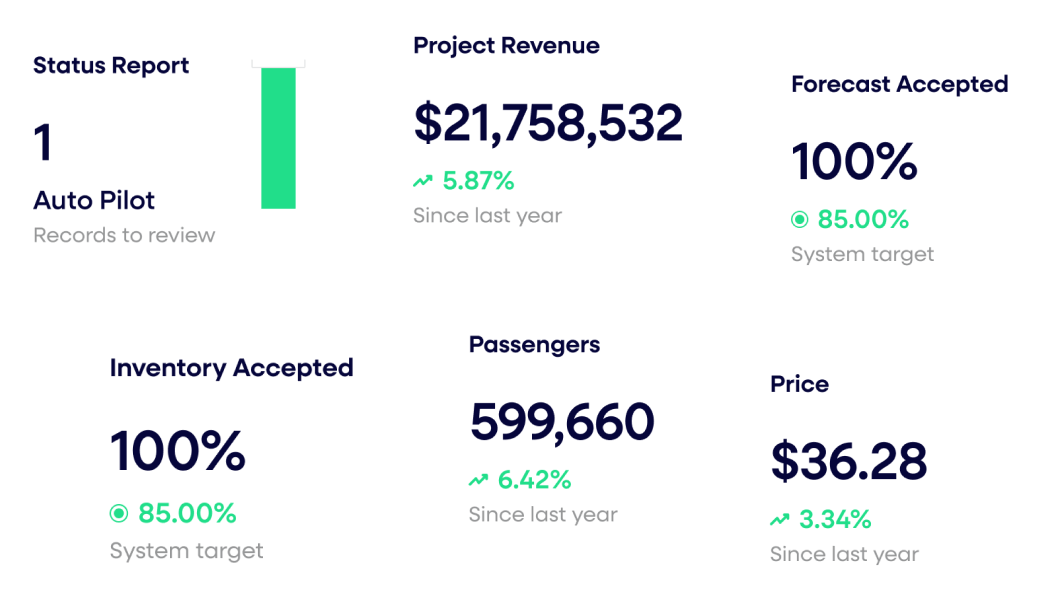Rail Operator Exceeds Revenue Goals and Lofty Customer Expectations
This Revenue Analytics customer is a leading European rail operator with annual revenue of more than £650 million. They serve a mixture of commuter and leisure passengers across thousands of unique journeys (origin/destination).

Who Are They?
(This company’s name has been redacted, at their request, to protect the market advantage they enjoy by using Revenue Analytics software).
This Revenue Analytics customer is a leading European rail operator with annual revenue of more than £650 million.
They serve a mixture of commuter and leisure passengers across thousands of unique journeys (origin/destination).
As with most operators, customers expect a full range of options for fares and schedules, plus an excellent travel experience.
What Kept Them Awake at Night?
The Revenue Management team had two tough goals:
- Achieve ambitious revenue growth targets.
- Ensure an excellent customer experience (more travel choices, reasonable fares, more low-cost fares, and no overcrowding).
What’s more, there was another challenge coming up fast : a new reservation system that would increase the number o f price points to manage by a factor o f 100 .
Given their existing processes and systems, the team was fighting an uphill battle. They simply would not be able to manage the expanded number of fares.
4 Key Challenges
This operator realized their legacy Revenue Management System (RMS) was not up to the task for four key reasons…
1
Managing fares by business rules left many journeys neglected—and money on the table.
Revenue Managers didn’t have the time to review all the fare recommendations, so they used high-level business rules to “set and forget” their pricing strategy. Then, when demand increased for any of the journeys, the operator was missing out on revenue.
2
The legacy RMS automated few functions, so Revenue Managers did most of their work in Excel.
This operator’s legacy RMS had transitioned from actively managing the fares to just being a tool for uploading allocations to the reservation system. That meant Revenue Managers were doing most of their work manually, in Excel spreadsheets.
3
As schedules changed, Revenue Managers had to manually reset fares.
There were frequent schedule changes as well as engineering work, but the legacy RMS was incapable of automatically accommodating the capacity changes brought on by these events. Revenue Managers had to manually adjust the fares when these changes happened, and that took a lot of time.
4
Fare recommendations were often ignored due to inaccurate demand forecasts and price sensitivities.
Revenue Managers had very little confidence in the demand forecasts generated by the legacy RMS. Also, price sensitivities had not been updated in years. Taken together, these technical shortcomings created a lack of trust in the fare recommendations across the board.
Selection & Implementation
Company chooses next-gen RMS solution from Revenue Analytics
They realized that it was time for a change, so they researched existing RMS solutions for Passenger Rail. They evaluated numerous vendors, but they couldn’t find a system that would solve their big challenges.
Why Revenue Analytics?
The company chose FareVantage™ RMS by Revenue Analytics for 3 key reasons:
- They were looking for an RMS with advanced analytics, automation, and an elegant user experience.
- They wanted an RMS built specifically for modern train operators.
- They wanted a provider with proven Revenue Management experience and the ability to tailor an RMS to their needs.
Step 1: In-depth consultation
To begin, Revenue Analytics worked with the rail operator’s Revenue Management team to understand their current processes and objectives.
And with the team’s input, Revenue Analytics configured the software to support the way the team worked and what they wanted to accomplish.
Step 2: Data prep and model testing
Revenue Analytics deployed an extensive library of analytics consisting of 1,500+ unique predictive models across demand forecasting and price sensitivities, ensure pricing recommendations made sense.
Step 3: Selecting predictive models
FareVantage™ auto-selected the best-fit model for each and every journey, ensuring fare recommendations that maximize both revenue and ridership.
Step 4: Training for day-to-day use
To ensure a smooth transition to the new RMS, Revenue Analytics provided in-depth training. And they continue to provide support today.
The Results
An independent auditor evaluated the performance of the Revenue Analytics RMS, finding:
- 3% revenue uplift, exceeding the initial target of 2%.
- An increase in ridership, from incentivizing demand shifts to less busy trains and opening availability on historically price constrained journeys.
- 15x ROI over three years.
Further, the rail operator has addressed all the challenges it identified at the beginning of this process:
- Pricing is now automated for more than 80% of journeys.
- Capacity shifts from engineering work and schedule changes are handled automatically.
- Demand forecast accuracy has improved by more than 35%.
- Special-event demand is addressed more effectively.
- Price sensitivities are now updated on a defined schedule.
The Revenue Management team now has user-friendly software to manage their day-to-day work.
The new Revenue Analytics RMS has improved the team’s daily productivity by providing the key data they need.
The system also highlights where their human expertise can best be utilized. The team now spends its time on strategic decision making instead of working in Excel spreadsheets and manually uploading allocations through a legacy system.
With all these exciting changes and a next-generation RMS configured specifically for passenger rail, the operator is now truly “on-track’ for revenue and customer success.

